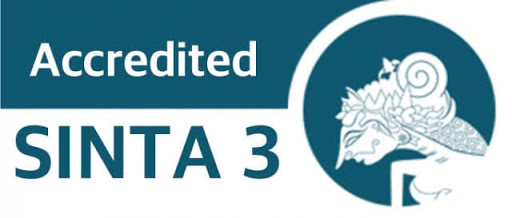THE ACADEMIC STRESS OF MALE AND FEMALE STUDENTS AT SMA N 1 PASIR PENYU IN ONLINE LEARNING DURING THE COVID-19 PANDEMIC
Abstract
The Covid-19 pandemic has made students learn through online learning, which is different from face-to-face learning. As a result, several problems might occurred due to this changing both for students and teachers. Online learning caused students to experience various academic problems, such as unstable internet connections, difficulties in understanding the materials, having more assignments, additional costs for buying internet packages, being unfamiliar with the online learning system, and increasing parents’ burden to help children in learning. Some of the problems mentioned above became a stressor for students in taking online learning. Based on the phenomenon reported by BK teachers at schools, male students were less disciplined in managing time during online learning. it was found that many male students skipped the class during online learning; many assignments were not submitted on time. As a result, their academic achievement decreased. On the other hand, female students focused more on the online learning and they were more likely to stay at home, so that it was easier for them to adapt to online learning compared to male students. The purpose of this study was to determine the differences in the level of academic stress of male and female students. The research samples were 155 students and the instrument in this study was an academic stress scale. This study obtained that the validity of the instruments was 0.3 and the reliability was 0.875. Then, the data were analyzed by independent sample T-test and descriptive analysis. The results showed that there were differences in the academic stress of male students and female students, in which the academic stress of the male students was higher than the academic stress of the female students.
Keywords
Full Text:
PDF (BAHASA INDONESIA)References
AlAteeq, D. A., Aljhani, S., & AlEesa, D. (2020). Perceived stress among students in virtual class- rooms during the COVID-19 outbreak in KSA. Journal of Taibah University Medical Sci- ences, 15(5), 398-403.
Anugrahana, A. (2020). Hambatan, Solusi dan Har pan: Pembelajaran Daring Selama Masa Pandemi Covid-19 Oleh Guru Sekolah Dasar. Scholaria: Jurnal Pendidikan dan Kebudayaan, 10(3), 282-289.
Aryani, F. (2016). Stres Belajar: Suatu Pendeka tan dan Intervensi Konseling. Sulawesi Tengah: Edukasi Mitra Grafika.
Barseli, M., Ifdil, I., & Nikmarijal, N. (2017). Konsep stres akademik siswa. Jurnal Konseling dan Pen- didikan, 5(3), 143-148.
Chandra, Y. (2020). Online education during COVID 19: perception of academic stress and emotional intelligence coping strategiesamong college students. Asian Education and Development Studies.
Desmita. (2016). Psikologi Perkembangan Peserta Didik. Bandung: PT. Remaja Rosdakarya
Harahap, A. C. P., Harahap, D. P., & Harahap, S. R. (2020). Analisis Tingkat Stres Akademik Pada Mahasiswa Selama Pembelajaran Jarak Jauh Dimasa Covid-19. Biblio Couns: Jurnal Kajian Konseling dan Pendidikan, 3(1), 10-14.
Lazarevic, Bojan & David Bentz. (2020). Student Pe ception of Stress in Online and Face-to-Face Learning: The Exploration of Stress Determi- nants, American Journal of Distance Education, DOI: 10.1080/08923647.2020.1748491
Liu, Y., & Lu, Z. (2012). Chinese high school stdents' academic stress and depressive symp toms: gender and school climate as moderators. Stress and Health, 28(4), 340-346.
Livana, P. H., Mubin, M. F., & Basthomi, Y. (2020). " Learning Task" Attributable to Students' Stress During the Pandemic Covid-19. Jurnal Ilmu Keperawatan Jiwa, 3(2), 203-208.
Mahapatra, A., & Sharma, P. (2020). Education in times of COVID-19 pandemic: Academic stress and its psychosocial impact on children and ad- olescents in India. International Journal of So- cial Psychiatry, 0020764020961801.
Mishra, M. (2018). A comparative study on academic stress level of male and female B. Ed. Stu- dents. Indian Journal of Health & Wellbe- ing, 9(1).
Misra, R., McKean, M., West, S., & Russo, T. (2000). Academic stress of college students: Comparison of student and faculty percep tions. College Student Journal, 34(2).
Ratnasari, S., & Suleeman, J. (2017). Perbedaan regu lasi emosi perempuan dan laki-laki di perguruan tinggi. Jurnal Psikologi Sosial, 15(1), 35-46.
Ravindranath, I. S., & Ravindranth, R. (2020). Stress Level in Male and Female School Students. Stress, 7(3).
Santrock, John W. (2002). Life-span Development : Perkembangan Masa Hidup. Edisi. 5 jilid 2, Ja- karta : Erlangga.
Surjaweni, V. W., & Endrayanto, P. (2012). Statistika Untuk Penelitian.Yogyakarta: Graha Ilmu.
Ye, L., Posada, A., & Liu, Y. (2018). The moderating effects of gender on the relationship between academic stress and academic self efficacy. International Journal of Stress Ma agement, 25(S1), 56 61. https://doi.org/10.1037/str0000089
DOI: http://dx.doi.org/10.33578/pjr.v5i4.8440
Refbacks
- There are currently no refbacks.
Copyright (c) 2021 JURNAL PAJAR (Pendidikan dan Pengajaran)

This work is licensed under a Creative Commons Attribution-NonCommercial-ShareAlike 4.0 International License.
JURNAL PAJAR (Pendidikan dan Pengajaran)
Secretariat
Program Studi Pendidikan Guru Sekolah Dasar
Gedung B1, FKIP Universitas Riau
Kampus Bina Widya Km. 12,5 Simpang Baru Panam
Pekanbaru Riau Indonesia 28293
e-mail : pajar@ejournal.unri.ac.id



